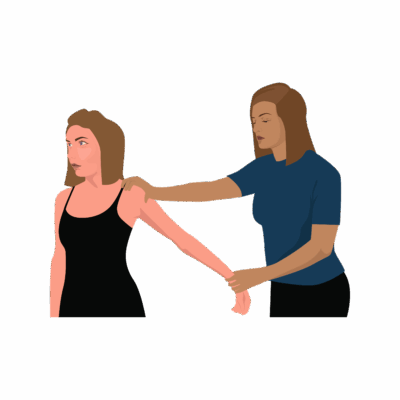Reverse Adson’s Test
The Reverse Adson’s Test (also called the Halstead Maneuver or Exaggerated Military Position) is an orthopedic assessment designed to evaluate for thoracic outlet syndrome (TOS) caused by compression of the brachial plexus and subclavian artery between the anterior and middle scalene muscles, or within the costoclavicular space. It is particularly useful when symptoms seem related to posture, shoulder depression, or downward load rather than neck rotation toward the tested side (as in standard Adson’s Test).
How the Test is Performed
-
Client position: Seated or standing.
-
The examiner palpates the radial pulse on the affected side while abducting the shoulder to about 45 degrees, extending and externally rotating the arm, and applying downward distraction to the limb.
-
The client is asked to rotate their head away from the tested extremity (contralateral rotation).
-
Sometimes, the examiner has the client actively roll their shoulders backwards and downwards in a “military brace” position, further narrowing the costoclavicular space.
-
The examiner monitors the radial pulse and asks about neurological symptoms (pain, paresthesia, weakness, cyanosis, swelling).
-
A positive test is indicated by absence or disappearance of the radial pulse during the maneuver (suggesting vascular compression), or reproduction of pain, tingling, or radiating symptoms (suggesting neurologic TOS).
Clinical Significance
-
A positive Reverse Adson’s Test points toward thoracic outlet syndrome with vascular or neurologic involvement due to compression at the interscalene triangle or costoclavicular space, especially in positions that depress and retract the shoulder.
-
It is especially meaningful when symptoms worsen with downward distraction or “military brace” postures, or activities involving heavy loads on the shoulders.
Assessment
-
Use the Reverse Adson’s Test for clients with upper extremity numbness, tingling, weakness, or vascular changes, particularly when symptoms are posture-dependent or load-driven.
-
Document pulse changes or neurovascular symptoms, and avoid deep pressure or aggressive massage over the scalene, clavicular, or subclavian regions (“endangerment sites”) if positive.
Treatment
-
Focus treatment on gentle soft tissue work for supporting upper back, rhomboids, and pectorals, in combination with postural education and ergonomic correction in chronic cases.
Safety and Referral
- Do not perform deep massage or strong mobilization work on clients with vascular or neurologic compression identified by this test until medically cleared.
-
Refer clients with a positive Reverse Adson’s Test for further medical assessment and diagnosis. This is important when symptoms are acute, severe, or rapidly worsening.
-
Collaborate with medical and rehabilitation providers to ensure safety and coordinated care.

